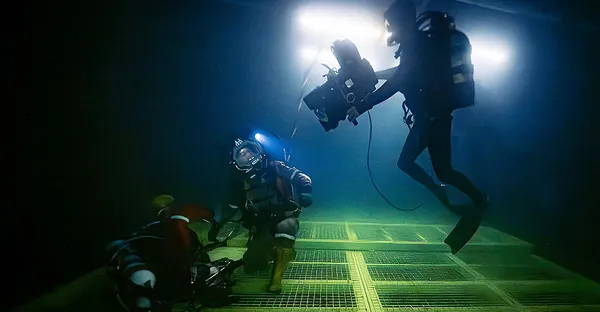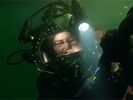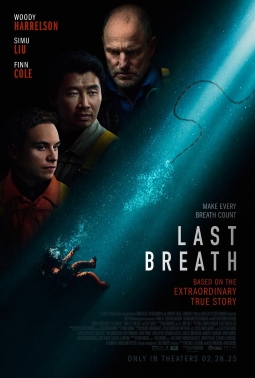Eye For Film >> Movies >> Last Breath (2025) Film Review
Last Breath
Reviewed by: Andrew Robertson

Based on a true story, Last Breath is set in the world of saturation diving. That's one of the most extreme environments for working men and women, with some of the most complex equipment sustaining them as they do so. Hundreds of feet below The North Sea, connected to the vessel storeys above through long umbilicals. More than cables, the pipes and tubes that run from pipe to diving bell carry signals, hot water to stop the divers freezing on the seabed, and air.
More than air, in fact. The pressures are such that compression and decompression take hours, days. Among the litany of diving accidents the horrific circumstances of the Byford Dolphin where five men were killed and a sixth critically injured by a single mechanical failure. There's far more to it than that, disasters always have at their root decisions made by others, as the saying goes, safety regulations are written in blood. There's a significant apparatus to support these divers. When Neil Armstrong became first man on the moon, his first step was from standing on the shoulders of tens of thousands of giants. They work in shifts, kept at pressure. Their lifeboat is also pressurised, akin to the escape capsules of astronauts. They're not trying to maintain a balance between one atmosphere and none, however. They are trying to stay safe across a gulf ten times as wide.

They are compressed by a column of water as tall as the Elizabeth Clock Tower of the Palace of Westminster. If you've ever stood at the foot and listened to Big Ben's chimes imagine that your feet were instead planted four hundred miles almost directly north among the pipework of the Aberdonian oilfields. The stone of Pugin and Barry's work will appear grey. Orange and yellow aren't visible at those depths. Colour is not the only thing that changes; what we breathe starts to become dangerous. The nitrogen in your lungs starts to work against you. You develop nitrogen narcosis, becoming giddy, delirious, losing focus mentally and visually. Dangerous in any circumstances but even more so in a hostile environment. Panic, and surface too quickly, and the there's the risk of decompression sickness. The 'bends' are one of dozens of symptoms, ranging in severity from itchiness to things with names like dysbaric osteonecrosis. To protect from that, the gases are different: a mixture of helium and oxygen is used.
That's the job. A dangerous one to start with. Heavy equipment and flammable material making up oilfield apparatus. Out in the North Sea, with only the Faroes between you and the Artic winds, sea swells where the waves can be taller than the rigs. Working under that water. Working in a place where it's only the work of dozens of others and complex machines stops you from dying. Where the air that you breathe is different than on the surface, because that would kill you. Where staying put is dangerous because the cold will kill you. Where leaving too quickly will kill you. Now imagine something goes wrong.
We don't have to, of course. This is based on a true story, and one that's been on film before. There's a 2018 documentary by the same team and I would suggest watching that instead. As with those gasses discussed previously, it's not that there's anything wrong, it's just that the mixture isn't good for the circumstance.
Though the film had the chance to shoot on board the vessel where the real events occured, much of it was shot in a studio in Malta. That makes the underwater sequences more achievable but little else convinces. The Bibby Topaz is now the Boka Topaz after a change of ownership but the vessel in the film is named Tharos. That's a nod to the support vessel that saved so many lives during the Piper Alpha disaster, but it's one of the few details that'll satisfy the eagle-eyed. Among the many dials and gauges is one for 'pitch control'. That's because the heliox mixture makes voices squeaky. That does sound comic, but it's part of the surreal atmosphere that Last Breath avoids.
The score appears to have been attributed to a copyright shop, which I think makes it library music. There's nothing inherently wrong with that, but a story this unique deserves better than generic music. Establishing shots of boats and docks and archive footage are not only more genuine than the film's version of events but more convincing. In places that's because drones are shooting in one format and the rest is captured in another. Much of the time it's an air of unreality from the cast.
Woody Harrelson's one of the few that's as bald and bluff as the real divers. Simu Liu's a Marvel superhero, so a reference to his emotional detachment in the nickname 'Vulcan' is perhaps as muddy as it is clumsy. Finn Cole holds his own in a role that sees him rack up another set of impressive co-stars, but he and Bobby Rainsbury (playing his character's fiancée) are underserved by a script that's often so wooden it could float.
The sea is scary. It is dark, and old, and does not want you there. We know this from any number of other films, other last breaths. It's more than the sharks and the depth: the deep water itself will get you. We don't get much sense of it from Last Breath, however. All those paragraphs at the start are more than we get from some expository dialogue. Could there have been more? One feels that, however heroic it comes across as, scenes of splicing ethernet cables to reboot a positioning system could have been removed to allow more time to set the stakes.
Director Alex Parkinson helmed the documentary, so knows the subject well. I'm not sure it's fair to call this a fiction début as it's a thin gloss over real events. To extend a painting metaphor, it's a patchy one though, and you can see the filler through it. He co-writes with David Brooks and Mitchell La Fortune, who have a 2009 short and a 2023 Gerard Butler vehicle between them. This is not new territory, nor is this a new approach. I was reminded of 2014's Pressure, which made better use of its cast though its circumstances were different. There I noted that it might have worked better as a play, and maybe it's the thought that black box theatre and a single spotlight would do a better job of signalling the isolation of these circumstances better than either of these films. This Last Breath isn't worth holding onto.
Reviewed on: 08 Mar 2025

















